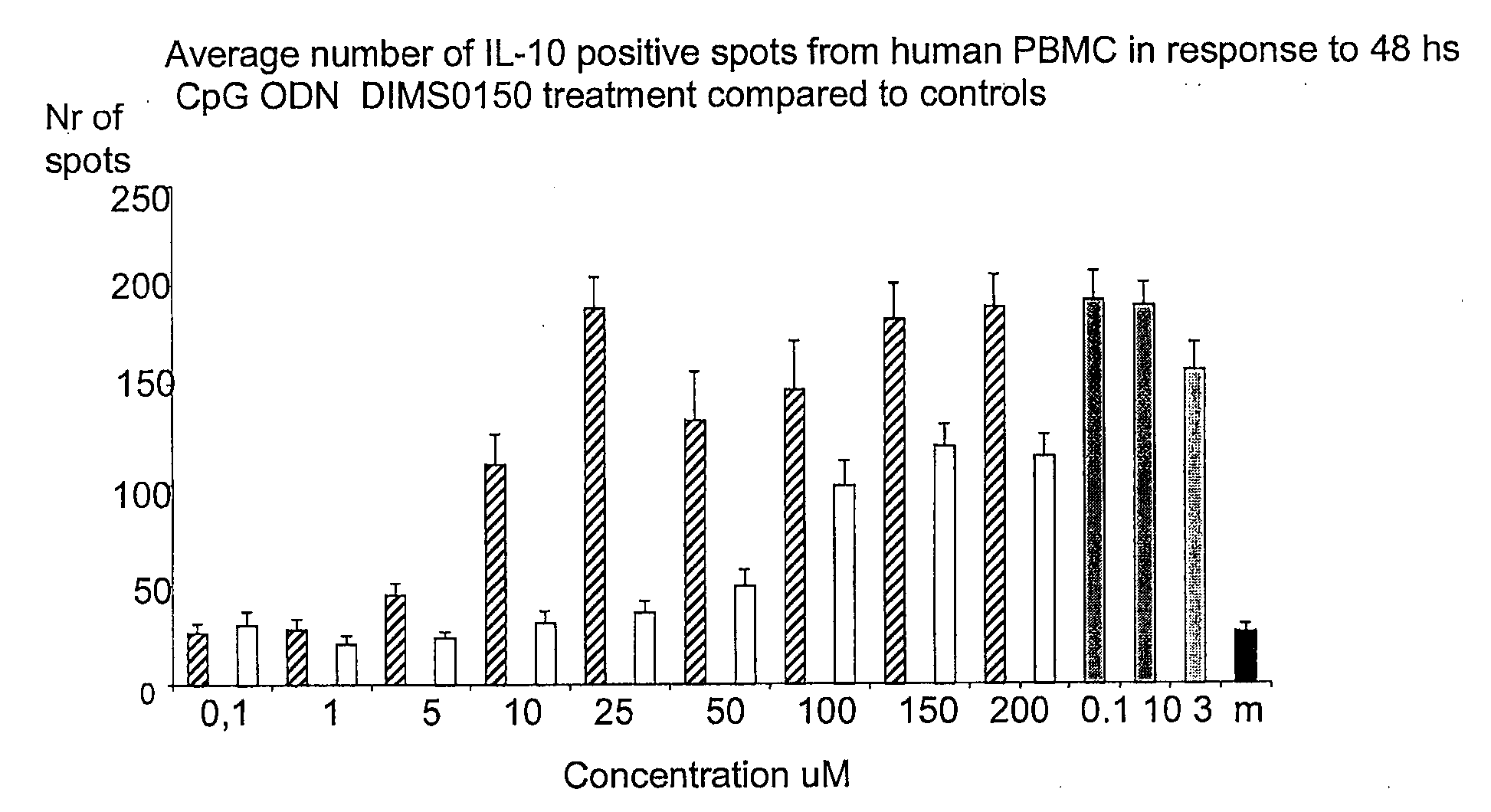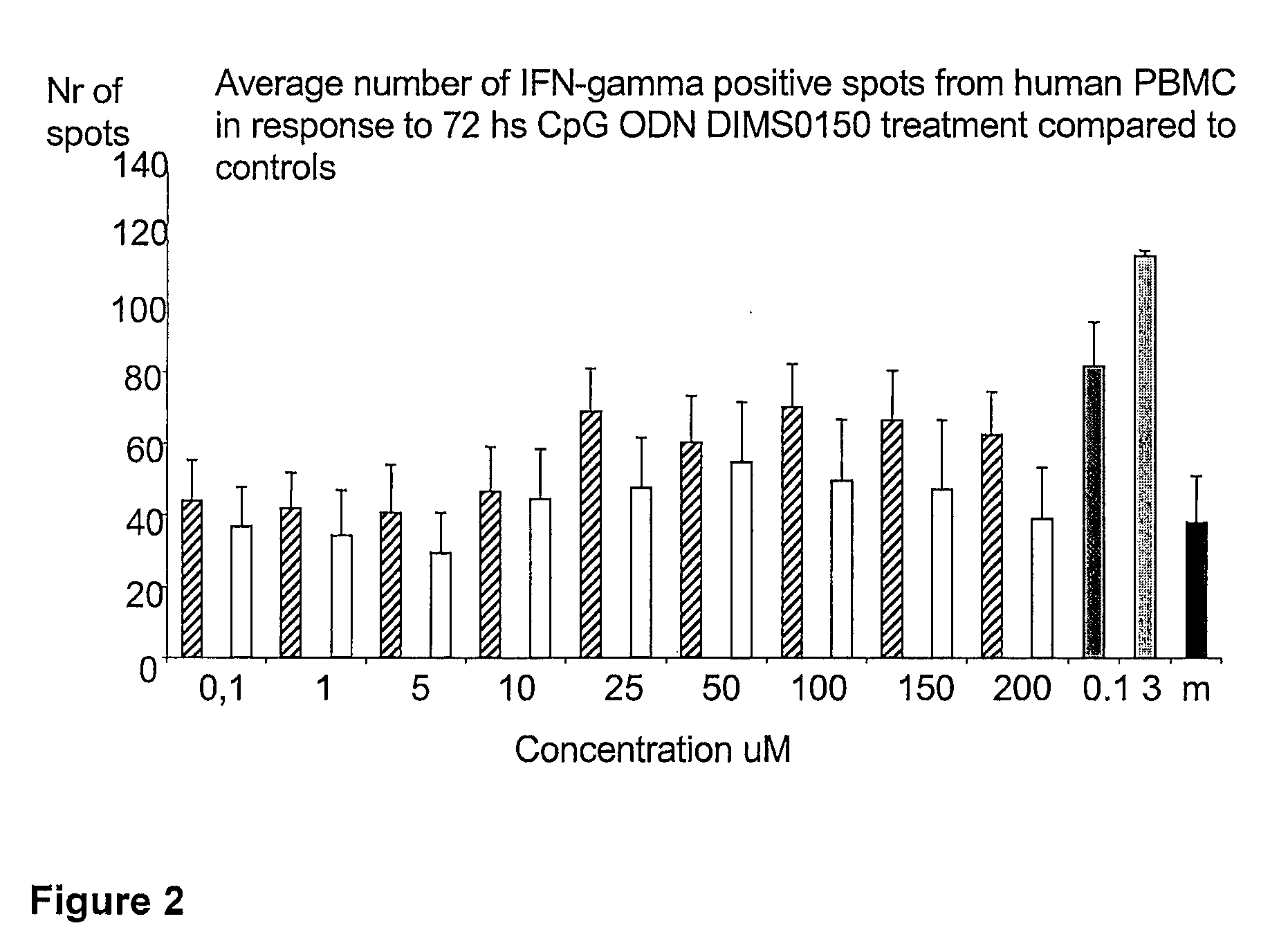Method for Modulating Responsiveness to Steroids
a technology of responsiveness and steroid, applied in the direction of sugar derivatives, biocide, plant growth regulators, etc., to achieve the effect of reducing the dosing level of anti-inflammatory treatment and enhancing steroid efficacy
- Summary
- Abstract
- Description
- Claims
- Application Information
AI Technical Summary
Benefits of technology
Problems solved by technology
Method used
Image
Examples
example 1
Evaluation of Cytokine Production of PBMC Upon Stimulation with DIMS0150
[0105]The immunostimulatory activity of the CpG containing ODN, DIMS0150, was evaluated in human PBMC. The hypothesis was that PBMC incubated with different concentrations of DIMS0150 for different periods of time would stimulate cytokine production in a CpG dependent manner. For this reason, three cytokines that are well known to be produced by PBMC in response to CpG DNA, namely IFN-alpha, IL-10 and IFN-gamma were chosen. Indeed, PBMC from different healthy donors all showed time (data not shown) and dose dependent cytokine production as analysed by ELISpot in response to DIMS0150. Among the three cytokines tested, IL-10 was the most responding cytokine after 48 hrs stimulation with DIMS0150 (FIG. 1.). In contrast to IL-10, DIMS0150 was less potent at inducing IFN-alpha and IFN-gamma in PBMC at all concentrations and time points tested, represented by 72 hrs for IFN-gamma (see FIG. 2) and 48 hrs for IFN-alpha ...
example 2
Quantification of Cytokine Production of PBMC in Response to DIMS0150
[0106]In order to quantify the amount of cytokine produced from the positive cells observed by ELISpot, ELISA analyses were performed. PBMC were incubated with increasing concentrations of DIMS0150 and the supernatants were analyzed for levels of IL-10, IFN-alpha and IFN-gamma. In agreement with those results obtained by ELISpot data, using concentrations between 0.1 and 200 μM (or 300 μM for IFN-alpha and IFN-gamma) resulted in a CpG dependent dose response of all the cytokines after 48 hrs incubation (see FIGS. 4 A, B and C). Since ELISpot and ELISA measure different parameters (i.e. number of cells secreting a particular cytokine versus the amount of secreted cytokine) the ELISA measurements should be considered as complementary information regarding the actual amount being produced at an particular concentration, regardless of the number of cells secreting the cytokine of interest. Thus, the dose response patte...
example 3
Comparison of DIMS0150 with Different CpG ODNs in PBMC
[0107]A dose response of DIMS0150 stimulation was compared with that of known human and murine CpG ODNs, IDX0910 and IDX0920, respectively. In addition, IDX0250 was also included in this experimental set up, since this ODN sequence also contains a CpG dinucleotide and may act as CpG DNA. The CpG flanking bases in IDX0250 differ slightly to DIMS0150 and this may influence the level of cytokine response in PBMC upon stimulation. In this investigation, PBMC were treated for 48 hours with the CpG ODNs and their respective reversed GpC controls before supernatants were analyzed in duplicate using quantitative ELISA assays for IL-10 and IFN-gamma DIMS0150 and the IDX0250 gave rise to a similar IL-10 response at 100 μM (FIG. 5.) but at the lowest concentrations (0.1 μM to 1 μM), none of these ODNs stimulated IL-10 production of PBMC. In comparison, PBMC incubation with IDX0910 or IDX0920 reached the highest IL-10 production at the lower...
PUM
| Property | Measurement | Unit |
|---|---|---|
| Fraction | aaaaa | aaaaa |
| Fraction | aaaaa | aaaaa |
| Fraction | aaaaa | aaaaa |
Abstract
Description
Claims
Application Information
 Login to View More
Login to View More - R&D
- Intellectual Property
- Life Sciences
- Materials
- Tech Scout
- Unparalleled Data Quality
- Higher Quality Content
- 60% Fewer Hallucinations
Browse by: Latest US Patents, China's latest patents, Technical Efficacy Thesaurus, Application Domain, Technology Topic, Popular Technical Reports.
© 2025 PatSnap. All rights reserved.Legal|Privacy policy|Modern Slavery Act Transparency Statement|Sitemap|About US| Contact US: help@patsnap.com



